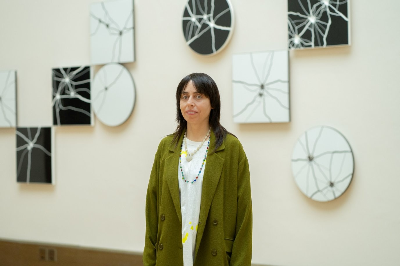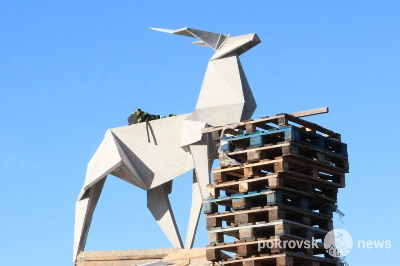
© Facebook Zhanna Kadyrova
Художниця Жанна Кадирова офіційно представить Україну на 61-й Венеційській бієнале сучасного мистецтва, що триватиме з 9 травня по 22 листопада 2026 року. Її проєкт під назвою «Гарантії безпеки» буде основою національного павільйону та створений у співпраці з кураторами Ксенією Малих і Леонідом Марущаком. У центрі проєкту — скульптура Жанни Кадирової «Олень» із серії «Оригамі», що була встановлена в парку «Ювілейний» у Покровську (Донецька область) у 2019 році. Скульптуру тоді розмістили на постаменті, з якого демонтували радянський реактивний літак, що символізував військову потужність Радянського Союзу. У 2024 році, під час евакуації жителів Покровська, ГО «Музей відкрито на ремонт» вивезла скульптуру оленя із зони бойових дій. У складі ініціативної групи був історик та співкуратор проєкту Леонід Марущак. Окрім самої скульптури оленя, в експозиції також буде представлений документальний фільм «ВПО», створений за участі Наталки Дяченко, що зафіксував процес евакуації скульптури з фрагментами розмов із місцевими жителями. А також архівні матеріали, пов’язані з парком у Покровську та Будапештським меморандумом -відповідно до прес-релізу Промприлад Артцентр.
Жанна Кадирова, народилася 1981 року. Скульпторка, художниця, одна з провідних представниць сучасного українського мистецтва. Лауреатка премій Казимира Малевича, Шевченківської премії, а також першої премії Her Art Award — за серію робіт «Біженці», присвячену війні в Україні. Представляла Україну на Венеційській бієнале 2013 року, була учасницею багатьох міжнародних виставок і арт-резиденцій. Венеційська бієнале традиційно є не лише мистецьким, а й політичним майданчиком. Україна вже кілька років використовує цю платформу для культурної дипломатії — і проєкт Кадирової цю лінію продовжує. Через мову матеріалів, архітектури та символів мисткиня говорить про крихкість миру, втрату довіри та моральну відповідальність світу. У соцмережах та арт-спільнотах інсталяцію вже називають «голосом нації, яка переживає війну». Проєкт викликає резонанс як у професійному середовищі, так і серед ширшої аудиторії, зокрема молоді, яка шукає нові форми вираження національної ідентичності.
Zhanna Kadyrova to Represent Ukraine at the 2026 Venice Biennale with “Security Guarantees”
Artist Zhanna Kadyrova will officially represent Ukraine at the 61st Venice Biennale of Contemporary Art, which will run from May 9 to November 22, 2026. Her project, entitled “Security Guarantees,” will form the basis of the national pavilion and was created in collaboration with curators Ksenia Malykh and Leonid Marushchak. At the center of the project is Zhanna Kadyrova's sculpture “Deer” from the “Origami” series, which was installed in Yubileiny Park in Pokrovsk (Donetsk region) in 2019. The sculpture was then placed on a pedestal from which a Soviet jet plane, symbolizing the military power of the Soviet Union, had been dismantled. In 2024, during the evacuation of Pokrovsk residents, the NGO Museum Open for Renovation removed the deer sculpture from the combat zone. The initiative group included historian and co-curator of the project Leonid Marushchak. In addition to the deer sculpture itself, the exhibition will also feature the documentary film “IDP,” created with the participation of Natalka Dyachenko, which recorded the process of evacuating the sculpture with fragments of conversations with local residents. There will also be archival materials related to the park in Pokrovsk and the Budapest Memorandum, according to a press release from Promprylad Art Center.
Zhanna Kadyrova was born in 1981. She is a sculptor, artist, and one of the leading representatives of contemporary Ukrainian art. She is a laureate of the Kazimir Malevich Prize, the Shevchenko Prize, and the first Her Art Award for her series of works “Refugees,” dedicated to the war in Ukraine. She represented Ukraine at the 2013 Venice Biennale and has participated in many international exhibitions and art residencies. The Venice Biennale is traditionally not only an artistic but also a political platform. Ukraine has been using this platform for cultural diplomacy for several years, and Kadyrova's project continues this line. Through the language of materials, architecture, and symbols, the artist speaks about the fragility of peace, the loss of trust, and the moral responsibility of the world. On social media and in art communities, the installation is already being called “the voice of a nation experiencing war.” The project resonates both in professional circles and among a wider audience, particularly young people who are looking for new forms of expressing national identity.

©
2144